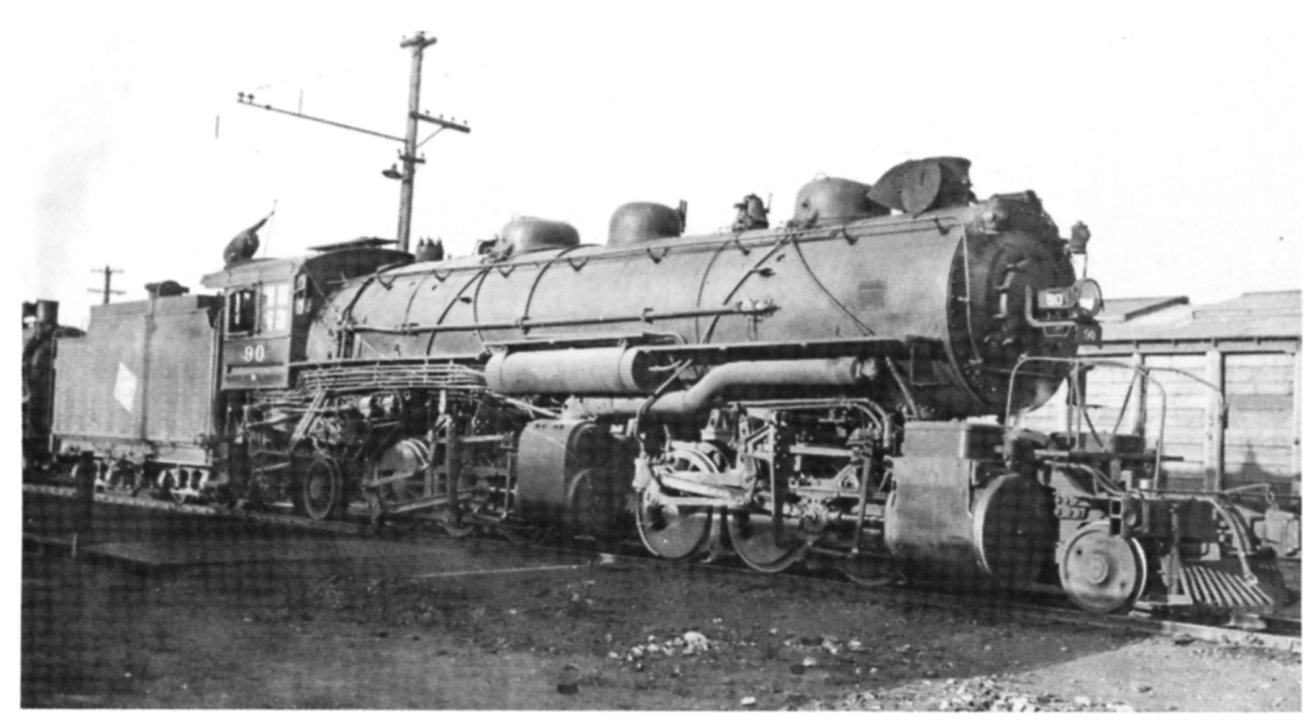- Details
- Hits: 263
Milwaukee brings big power to the U.P. - 1919
 Reprinted from Clover Land Magazine, July, 1919 by the Upper Peninsula Development Bureau.
Reprinted from Clover Land Magazine, July, 1919 by the Upper Peninsula Development Bureau.
The largest locomotive in the entire Upper Peninsula has just arrived at Channing. It is locomotive No. 9506 of the Chicago, Milwaukee & St. Paul Railroad. This is the first locomotive of its kind in Cloverland, and is without a peer on any other road in the U.P., either in weight, length or power. No. 9506 is the first of four similar engines which arrived at Channing the second week of April of tis year, and are of the St. Paul's largest class of engines on the entire system.
Photo Info: A similar CMStP Mallet, No. 90, which saw service in Michigan's upper peninsula, about 1920. [Greg Bunce collection]
No. 9506 is a Mallet Compound, Articulated 2-6-6-2 type, having two entirely separate groups of six drivers each, with two pair of cylinders, the back cylinders being the high pressure, 23 1/2 by 30 inches, and the front cylinders the low pressure, 37 by 30 inches. This engine has a total length of 98 feet 1 3/4 inches and the boiler carries a steam pressure of 250 pounds. Diameter of drivers is 57 inches.
It is of the St. Paul's class N2, built by the American Locomotive Company, and is equipped with Superheater, Walschaert Valve Gear, air operated power reverse gear and throttle, has an automatic stoker (probably the first engine also in the U.P. to be so equipped), and the engine and tender, without supply of coal and water, has a total weight of 591,700 pounds. The water capacity of the tender is 10,000 gallons, and of coal 18 tons. Thus loaded it would weigh considerably over 600,000 pounds (over 300 tons). Their tractive effort is something like 90,000 pounds.
These locomotives will no doubt hold the record for the largest engines in Cloverland for some time. They also have the distinction of being the highest numbered engines in the U.P.
The engines are to operate between Channing and Crystal Falls Junction, and Channing and Bates Junction, hauling 85 loaded cars of iron ore eastbound, and 125 empty ore cars westbound. The ore from the Crystal Falls district is assembled at Crystal Falls Junction, and that from the Iron River District at Bates Junction by switch engines; it is then hauled to Channing by these huge locomotives, for running gear inspection. From Channing the ore is brought to the Escanaba ore docks by another class of engines.
The railroad uses eight class L2 Superheater Mikado type engines which are assigned to the Channing terminal for ore service. This class of power is also being used between Green Bay, WI and Channing in freight service. This engine has a total weight of 497,000 pounds without a supply of coal and water, has a total length of 82 feet, and boiler pressure of 200 pounds. The tender capacity is also 10,000 gallons of water and 16 tons of coal.
These locomotives all have their headquarters at Channing, the center of the CM&StP railroads activities in the Upper Peninsula, and it would be worth your while to stop and look around for one of these Mallets on one of your automobile trips in the vicinity of Channing. They are so much longer than most of the locomotives you see that you cannot fail to identify one at first sight.
The location of Channing on the lines of the CM&StP in the Upper Peninsula may be likened to the hub of a wheel, or better still, to the palm of a hand (with Channing in the palm) and Escanaba, Champion, Houghton, Ontonagon, and Iron River termini at the finder tips, and Green Bay terminal at the wrist. It is rumored that the CM&StP are to make additions and enlargements to their yards and plant at Channing as soon as conditions will permit, in the way of machine shops, round-house, etc.
Channing is quite a village, it has four hotels, two large general stores, drug store, fruit store and ice cream parlor, etc., and is the junction point on the Escanaba & Lake Superior railroad with the Chicago, Milwaukee & St. Paul.
Bibliography
The following sources are utilized in this website. [SOURCE-YEAR-MMDD-PG]:
- [AAB| = All Aboard!, by Willis Dunbar, Eerdmans Publishing, Grand Rapids ©1969.
- [AAN] = Alpena Argus newspaper.
- [AARQJ] = American Association of Railroads Quiz Jr. pamphlet. © 1956
- [AATHA] = Ann Arbor Railroad Technical and Historical Association newsletter "The Double A"
- [AB] = Information provided at Michigan History Conference from Andrew Bailey, Port Huron, MI

